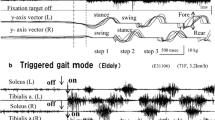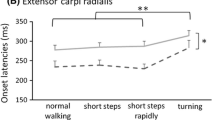Abstract
In bipedal gait, the initiation of the first step is preceded by a complex sequence of movements which shift the centre of mass of the body towards the stance foot to allow for a step of the swing foot. These anticipatory postural adjustments (APAs) have been investigated in order to elucidate movement strategies in healthy and diseased persons. We studied the influence of several external parameters (age, type of step initiation) on APAs and investigated whether Parkinsonian patients may have different APAs. As a result, we found that externally elicited steps were preceded by faster and larger APAs than self-timed steps. Parkinsonian patients without the freezing of gait (FOG) phenomenon showed overall slightly reduced APAs but did not clearly differ from patients with FOG. Multiple APAs were seen in up to 25 % of the steps of the patients and in a much lower percentage of the steps of control subjects. The results indicate that APAs are significantly influenced by the timing of a step, i.e. are larger in externally elicited steps. The patients showed an overall preserved APA pattern but slowed movements and amplitude, indicating that increased bradykinesia due to progressive illness is a plausible explanation for these findings. The freezing phenomenon is not explained by a general absence or massive reduction in APA measures.





Similar content being viewed by others
References
Assaiante C, Woollacott M, Amblard B (2000) Development of postural adjustment during gait initiation: kinematic and EMG analysis. J Mot Behav 32:211–226
Benecke R, Rothwell JC, Dick JP, Day BL, Marsden CD (1987) Disturbance of sequential movements in patients with Parkinson’s disease. Brain 110(Pt 2):361–379
Burleigh-Jacobs A, Horak FB, Nutt JG, Obeso JA (1997) Step initiation in Parkinson’s disease: influence of levodopa and external sensory triggers. Mov Disord 12:206–215
Crenna P, Frigo C (1991) A motor programme for the initiation of forward-oriented movements in humans. J Physiol 437:635–653
Crenna P, Carpinella I, Rabuffetti M, Rizzone M, Lopiano L, Lanotte M, Ferrarin M (2006) Impact of subthalamic nucleus stimulation on the initiation of gait in Parkinson’s disease. Exp Brain Res 172:519–532
Delval A, Moreau C, Bleuse S, Tard C, Ryckewaert G, Devos D, Defebvre L (2014) Auditory cueing of gait initiation in Parkinson’s disease patients with freezing of gait. Clin Neurophysiol 125:1675–1681
Fling BW, Cohen RG, Mancini M, Nutt JG, Fair DA, Horak FB (2013) Asymmetric pedunculopontine network connectivity in parkinsonian patients with freezing of gait. Brain 136:2405–2418
Fling BW, Cohen RG, Mancini M, Carpenter SD, Fair DA, Nutt JG, Horak FB (2014) Functional reorganization of the locomotor network in Parkinson patients with freezing of gait. Plos One 9:e100291
Gantchev N, Viallet F, Aurenty R, Massion J (1996) Impairment of posturo-kinetic co-ordination during initiation of forward oriented stepping movements in parkinsonian patients. Electroencephalogr Clin Neurophysiol 101:110–120
Giladi N, Shabtai H, Simon ES, Biran S, Tal J, Korczyn AD (2000) Construction of freezing of gait questionnaire for patients with Parkinsonism. Parkinsonism Relat Disord 6:165–170
Halliday SE, Winter DA, Frank JS, Patla AE, Prince F (1998) The initiation of gait in young, elderly, and Parkinson’s disease subjects. Gait Posture 8:8–14
Hanakawa T, Fukuyama H, Katsumi Y, Honda M, Shibasaki H (1999) Enhanced lateral premotor activity during paradoxical gait in Parkinson’s disease. Ann Neurol 45:329–336
Hiraoka K, Matuo Y, Iwata A, Onishi T, Abe K (2006) The effects of external cues on ankle control during gait initiation in Parkinson’s disease. Parkinsonism Relat Disord 12:97–102
Iansek R, Huxham F, McGinley J (2006) The sequence effect and gait festination in Parkinson disease: contributors to freezing of gait? Mov Disord 21:1419–1424
Jacobs JV, Horak FB (2007) External postural perturbations induce multiple anticipatory postural adjustments when subjects cannot pre-select their stepping foot. Exp Brain Res 179:29–42
Jacobs JV, Lou JS, Kraakevik JA, Horak FB (2009a) The supplementary motor area contributes to the timing of the anticipatory postural adjustment during step initiation in participants with and without Parkinson’s disease. Neuroscience 164:877–885
Jacobs JV, Nutt JG, Carlson-Kuhta P, Stephens M, Horak FB (2009b) Knee trembling during freezing of gait represents multiple anticipatory postural adjustments. Exp Neurol 215:334–341
Jiang Y, Norman KE (2006) Effects of visual and auditory cues on gait initiation in people with Parkinson’s disease. Clin Rehabil 20:36–45
Kanekar N, Aruin AS (2014a) Aging and balance control in response to external perturbations: role of anticipatory and compensatory postural mechanisms. Age (Dordr) 36:9621
Kanekar N, Aruin AS (2014b) The effect of aging on anticipatory postural control. Exp Brain Res 232:1127–1136
Laessoe U, Voigt M (2013) Step adjustments among young and elderly when walking toward a raised surface. Aging Clin Exp Res 25:299–304
Latash ML, Huang X (2015) Neural control of movement stability: lessons from studies of neurological patients. Neuroscience 301:39–48
Lee RG, Tonolli I, Viallet F, Aurenty R, Massion J (1995) Preparatory postural adjustments in parkinsonian patients with postural instability. Can J Neurol Sci 22:126–135
Malouin F, Richards CL (2000) Preparatory adjustments during gait initiation in 4-6-year-old children. Gait Posture 11:239–253
Mancini M, Zampieri C, Carlson-Kuhta P, Chiari L, Horak FB (2009) Anticipatory postural adjustments prior to step initiation are hypometric in untreated Parkinson’s disease: an accelerometer-based approach. Eur J Neurol 16:1028–1034
Mancini M, Chiari L, Holmstrom L, Salarian A, Horak FB (2016) Validity and reliability of an IMU-based method to detect APAs prior to gait initiation. Gait Posture 43:125–131
Mensink SH, Nonnekes J, van Bon G et al (2014) Additional weight load increases freezing of gait episodes in Parkinson’s disease; an experimental study. J Neurol 261:999–1008
Michely J, Volz LJ, Barbe MT et al (2015) Dopaminergic modulation of motor network dynamics in Parkinson’s disease. Brain 138:664–678
Naugle KM, Hass CJ, Bowers D, Janelle CM (2012) Emotional state affects gait initiation in individuals with Parkinson’s disease. Cogn Affect Behav Neurosci 12:207–219
Nocera JR, Roemmich R, Elrod J, Altmann LJ, Hass CJ (2013) Effects of cognitive task on gait initiation in Parkinson disease: evidence of motor prioritization? J Rehabil Res Dev 50:699–708
Nutt JG, Bloem BR, Giladi N, Hallett M, Horak FB, Nieuwboer A (2011) Freezing of gait: moving forward on a mysterious clinical phenomenon. Lancet Neurol 10:734–744
Peterson DS, Fling BW, Mancini M, Cohen RG, Nutt JG, Horak FB (2015) Dual-task interference and brain structural connectivity in people with Parkinson’s disease who freeze. J Neurol Neurosurg Psychiatry 86:786–792
Rocchi L, Chiari L, Mancini M, Carlson-Kuhta P, Gross A, Horak FB (2006) Step initiation in Parkinson’s disease: influence of initial stance conditions. Neurosci Lett 406:128–132
Rocchi L, Carlson-Kuhta P, Chiari L, Burchiel KJ, Hogarth P, Horak FB (2012) Effects of deep brain stimulation in the subthalamic nucleus or globus pallidus internus on step initiation in Parkinson disease: laboratory investigation. J Neurosurg 117:1141–1149
Schenk T, Baur B, Steude U, Botzel K (2003) Effects of deep brain stimulation on prehensile movements in PD patients are less pronounced when external timing cues are provided. Neuropsychologia 41:783–794
Uemura K, Yamada M, Nagai K, Tanaka B, Mori S, Ichihashi N (2012) Fear of falling is associated with prolonged anticipatory postural adjustment during gait initiation under dual-task conditions in older adults. Gait Posture 35:282–286
Vandenbossche J, Deroost N, Soetens E et al (2012) Freezing of gait in Parkinson’s disease: disturbances in automaticity and control. Front Hum Neurosci 6:356
Woollacott MH, Manchester DL (1993) Anticipatory postural adjustments in older adults: are changes in response characteristics due to changes in strategy? J Gerontol 48:M64–M70
Acknowledgments
This project was supported financially by the Lüneburg heritage (no involvement in the study design, the collection, analysis and interpretation of data, the writing of the manuscript or the decision to submit the manuscript for publication). We are also grateful to Mrs. K. Ogston for careful proofreading the manuscript.
Author information
Authors and Affiliations
Corresponding author
Rights and permissions
About this article
Cite this article
Plate, A., Klein, K., Pelykh, O. et al. Anticipatory postural adjustments are unaffected by age and are not absent in patients with the freezing of gait phenomenon. Exp Brain Res 234, 2609–2618 (2016). https://doi.org/10.1007/s00221-016-4665-x
Received:
Accepted:
Published:
Issue Date:
DOI: https://doi.org/10.1007/s00221-016-4665-x




